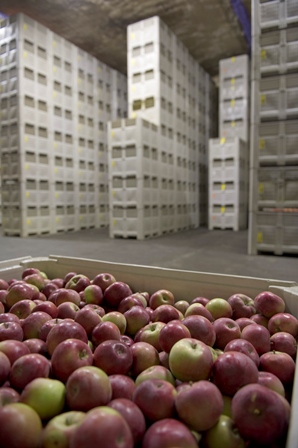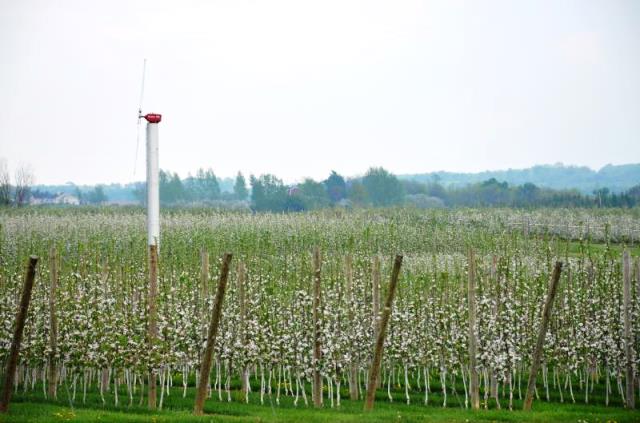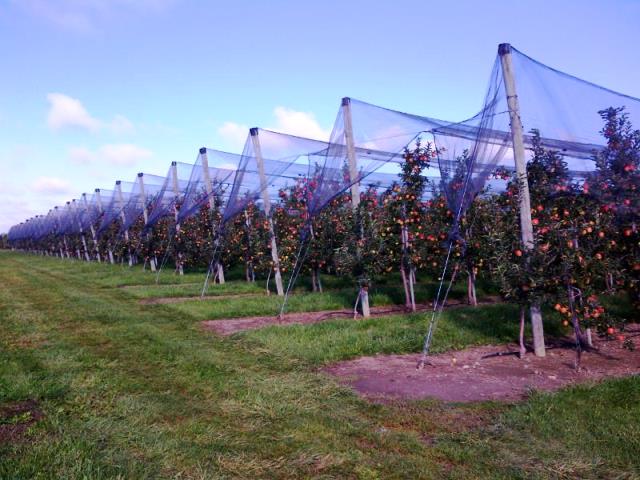
Apples, farmers and tech: A look at technologies used in apple growing
November 21, 2018
The traditional image many of us have of apple farming includes a big bushy tree, a ladder and some small baskets for picking.
That may have been true 50 years ago, but many of today’s Ontario apple growers have gone high tech in order to meet retailer and consumer demands for large volumes of high quality, locally grown apples for as much of the year as possible.
Here are a few of the ways growers are using technology to help them manage the weather, labour costs and shortages, and Ontario’s comparatively short growing season to grow the apples we all enjoy:
Controlled Atmosphere (CA) storage
Although apples are p opular during fall harvest, fresh Ontario apples are sold and consumed right through the winter and into the following spring. That’s possible due to controlled atmosphere (CA) storage systems which growers use to keep apples fresh until they go to market.
opular during fall harvest, fresh Ontario apples are sold and consumed right through the winter and into the following spring. That’s possible due to controlled atmosphere (CA) storage systems which growers use to keep apples fresh until they go to market.
Apples breathe just like people, taking in oxygen through their respiration process and generating carbon dioxide, water and heat. In CA storages, that respiration is reduced completely naturally by keeping the apples in an airtight environment and lowering the oxygen level inside from a normal level of 21 per cent down to two or three per cent. This stops the ripening process by essentially putting the apples to sleep (similar to hibernation in animals) until they are ready to go to market.
Apples for CA storage are picked at their peak of internal quality and condition and go into CA storage the day they are picked; how long they can stay in there depends on the characteristics of each apple variety.
Wind machines, frost fans and helicopters
 Early spring frosts can devastate fruit trees, causing smaller, unshapely and discolored apples or no apples at all if frost hits at blossom time. If there is a threat of frost, moving air will keep frost from settling on buds, blossoms and leaves.
Early spring frosts can devastate fruit trees, causing smaller, unshapely and discolored apples or no apples at all if frost hits at blossom time. If there is a threat of frost, moving air will keep frost from settling on buds, blossoms and leaves.
To keep air moving in their orchards and protect their trees against damage, some growers have installed large fans in their orchards, called frost fans. Once temperatures fall below a certain point, computerized fans automatically turn on and keep the orchard air circulating, preventing frost.
Other growers use wind machines, which are tall, fixed-in-place structures that pull warm air down to the trees from at least 15 m above ground. Although they look a bit like wind turbines, they are not the same thing – wind turbines create electricity from the wind, whereas wind machines simply circulate the air.
Some growers without fans or wind machines will turn to other ways to keep the air moving in their orchard during frosty nights, including flying helicopters in the threatened area over night.
Hail nets and cannons 
It takes just one summer hailstorm to destroy a prime apple crop – apples with hail damage can’t be sold into premium fresh markets, meaning they have to go into secondary markets like processing or juice. And for damaged apples, farmers receive only a fraction of what they would be paid for top quality, unblemished fruit.
To protect their crops, some growers are using large nets – think of mosquito netting while you’re camping, for example, that span over top of their trees along the orchard rows to keep hail from hitting the fruit. Others are using hail cannon technology based on sound waves to break up hailstones in the air before they fall and damage the crop.
Automated platforms
Instead of using ladders or having employees work from the ground, more and more apple growers are now using automated, moveable platforms in the orchard. Workers use the units during the growing season for tasks like tying, thinning and pruning trees, as well as for harvesting fruit in the fall.
The technology means workers can get their jobs done more quickly and more efficiently with less worker fatigue and greater worker safety. And because the platforms are self-steering and self-propelled, they travel up and down the orchard rows at a consistent speed, which allows for more uniform pruning and thinning.
Machine-based fruit tracking
Although not in Ontario yet, growers in Washington State are trialing a new technology that can count and size apples right on the tree, helping farmers with crop management. An ATV with an attached scanner can move through the orchard rows, filming trees to count the number of fruit on each tree as well as their size. Knowing apple size is important for farmers – they are paid on size and quality of their fruit, so this information can help them maximize the prices they receive.
Picking robot
Availability and cost of labour is an ongoing challenge for apple growers, leading them to constantly seek out new technologies. In Ontario for example, researchers at Vineland Research Innovation Centre are working on a prototype for an apple-picking robot, based on technology coming from Israel. The ultimate goal is for a multi-armed, autonomous robot that will use image sensing technology to assess apples for harvest readiness before picking them from the tree.
-30-

